The alarming spread of microplastics has become a problem that can no longer be ignored.
Microplastics are plastics measuring five millimetres or smaller and are formed when larger pieces of plastic such as shopping bags or bottles disintegrate into smaller pieces.
Due to their small size, the issue of microplastics might be seen as secondary to the “bigger” problem of plastic bags and other plastic goods which pollute the environment – but there is no escaping it.
From drinking water to the air we breathe and from the Mariana Trench to the Antarctic, microplastics are literally everywhere.
The World Economic Forum (WEF) estimates there are over 150 million tonnes of plastic in the ocean today and it is slowly damaging the planet’s already fragile environment.
Microbeads – found in exfoliating facial scrubs, shower gels, toothpaste and other personal care products – are a particularly dangerous form of microplastics. The United Kingdom’s (UK) Department for Environment, Food & Rural Affairs estimates that just one shower alone is thought to send 100,000 microbeads down the drain and into the ocean, causing serious harm to marine life.
Microplastics and marine life
Due to the relative lack of research on the topic, the effects of microplastics on humans and the environment will only be fully understood in the years to come.
With microplastics being ingested by marine animals that are then eaten by humans, the existence and impact of microplastics on the food chain – and its damage to our health – is slowly getting the public’s attention.
An estimated eight million tons of plastic finds its way into our oceans each year, and microplastics have been found in the stomachs of aquatic life ranging from anchovies to whales.
Studies in the Gulf of Thailand from August to November 2017 found that 67 percent of the fish caught had microplastics in their stomachs. Separate researchers in Thailand have also found microplastic in oysters and other invertebrates.
In Indonesia, a study last year found that up to 89 percent of anchovies fished in Indonesian waters had been contaminated by microplastics.
Examining 275 pieces of microplastics collected from three beaches in Singapore, researchers in the island state found more than 400 types of toxic bacteria – one of which is a major cause of wound infections and another which is known to cause diarrhoea and vomiting.
With our oceans so polluted with plastic, it should come as no surprise that a Greenpeace study last year found that over 90 percent of table salt used in kitchens globally contained microplastics – with the salt sold in Asia containing the highest levels.
Source: UN Environment
An issue ASEAN has to address
According to the WEF, the eight million tonnes of plastic which finds its way into our oceans every year is equivalent to dumping the contents of one garbage truck into the sea every minute.
If no action is taken, this amount is expected to increase to two garbage trucks per minute by 2030 and four per minute by 2050. In a business-as-usual scenario, the ocean is expected to contain one tonne of plastic for every three tonnes of fish by 2025, and by 2050, there will be more plastic than fish.
The problem has to be addressed at the source – companies which continue to produce single-use, non-recyclable plastic for their packaging.
The public has to rethink their consumption patterns and lawmakers should work on policies to encourage the 3Rs – reduce, reuse and recycle – and the implementation of a circular economy.
Although concrete steps have been taken to stop single-use plastic, ASEAN as a bloc should look at creating legislation to curb microplastics like their counterparts in Europe.
The European Union (EU) is planning a ban on microplastics in products such as cosmetics, paints, and fertiliser granules by 2020. If successful, it will ban over 90 percent of Europe’s microplastics and prevent about 30,000 tons of it polluting the environment every year.
Last June, the UK banned the sale of products containing microbeads – preventing retailers across England and Scotland from selling rinse-off cosmetics and personal care products that contain them.
Design overhauls for household products such as cosmetics, detergents and paints will be key to fighting the microplastic scourge, and there are ample natural substitutes that can be used in place of microbeads such as jojoba beads, ground oats and coffee.
Products used in construction, agriculture, fertiliser and fossil fuels will also have to be refined to eliminate microplastics.
Southeast Asia is one of the world’s biggest users of plastics and if the region fails to address the problem of microplastics, we will be depriving our future generations of a clean and sustainable environment.
Related articles:
